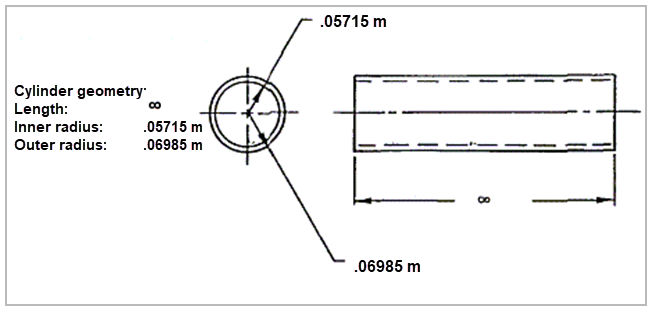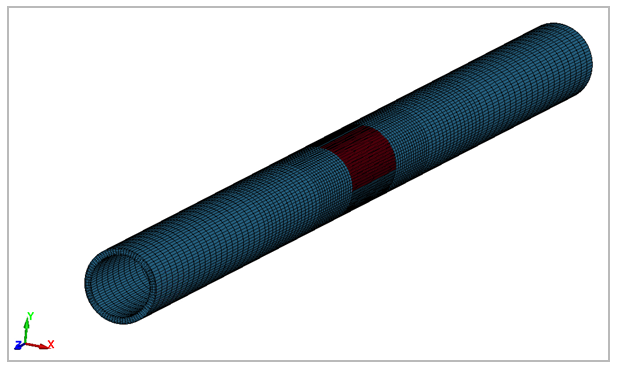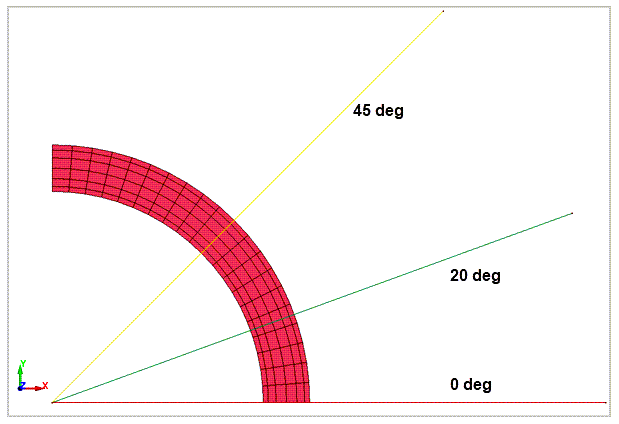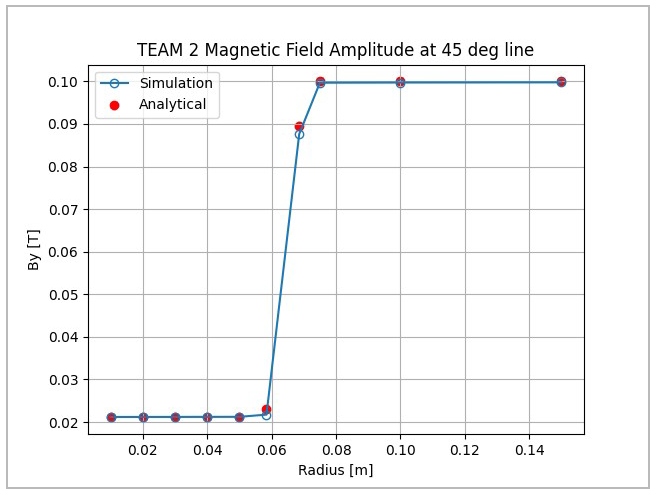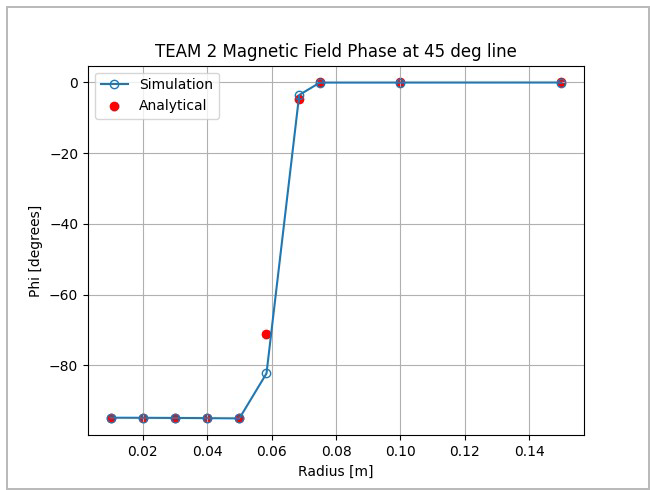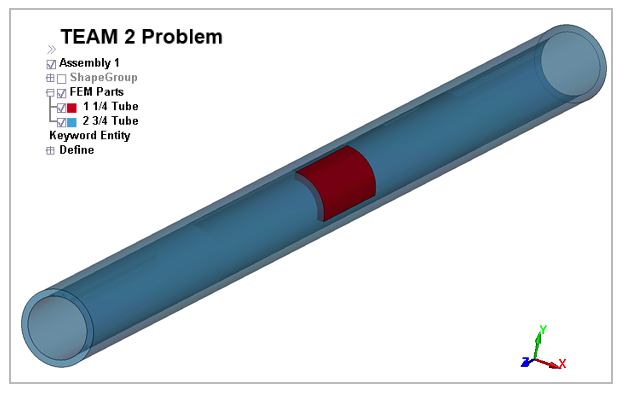VM-LSDYNA-EMAG-011
VM-LSDYNA-EMAG-011
Long Cylinder in a Uniform Sinusoidal Field (TEAM 2)
Overview
| Reference: | Ida, N. (1998). Infinite cylinder in a uniform sinusoidal field (comparison of results, problem 2). COMPEL - The International Journal for Computation and Mathematics in Electrical and Electronic Engineering, 7, 29-45. |
| Analysis Type(s): | Electromagnetism |
| Element Type(s): | Solid Elements ELFORM 1 |
| Input Files: | Link to Input Files Download Page |
Test Case
The TEAM 2 problem consists of an infinitely long cylinder, where a uniform field of 0.1 Tesla at 60 Hz is applied perpendicular to its axis. The cylinder is made of aluminum alloy 6061. The properties and loading are depicted below.
The objective of the test is to measure the amplitude and phase of the magnetic field along the Y axis. Points along three lines from (R = 0,Z = 0) to (R = 0.15,Z = 0) at 0 degrees, 20 degrees and 45 degrees are created, so that the magnetic field along these lines can be extracted and compared with the analytical solution. In addition, the total power loss and forces on the X and Y axes on one quarter of the cylinder are calculated.
The LS-DYNA model is not infinite but has a total length of two meters. The red section of the mesh is differentiated and finer to extract the power loss and the forces. The lines to extract the magnetic field are also shown below in Figure 223.
| Material Properties | Geometric Properties | Loading |
|---|---|---|
|
|
Analysis Assumptions and Modeling Notes
LS-DYNA *EM_CONTROL card is set to 4 to activate the Frequency-Based Eddy Current solver. The current is applied using *EM_EXTERNAL_FIELD pointing to a load curve, where the magnetic field along time is specified. In this case, since the magnetic field is constant, the curve is flat (values represented by the &B0 variable).

The mesh is formed by solid elements formulation 1, which is a constant stress solid element. The thickness of the cylinder is represented by six elements. The red part of the mesh is finer along the cylinder's axis to better capture some of the results.
Figure 224: Cut section of the mesh.

Results Comparison
The experimental results are compared with LS-DYNA output. Magnetic field results are extracted from em_pointout.dat for magnitude and em_pointout_phi.dat for phase.
The error between the analytical results and the simulation is presented in Table 27 through Table 32. There is a high level or correlation between the analytical solution and the solver. The largest discrepancies are for those points very close to and inside the cylinder.
Table 27: Amplitude y-Bfield at several cylinder radiuses for 0 degree line
| Result | Target (T) |
Workbench
LS-DYNA
(T) | Error (%) |
|---|---|---|---|
| y-Bfield (phase) at R = 0.01 m | 0.0211 | 0.0212 | 0.47 |
| y-Bfield (phase) at R = 0.02 m | 0.0211 | 0.0212 | 0.48 |
| y-Bfield (phase) at R = 0.03 m | 0.0211 | 0.0212 | 0.50 |
| y-Bfield (phase) at R = 0.04 m | 0.0211 | 0.0212 | 0.52 |
| y-Bfield (phase) at R = 0.05 m | 0.0211 | 0.0212 | 0.56 |
| y-Bfield (phase) at R = 0.05842 m | 0.028 | 0.0236 | 15.79 |
| y-Bfield (phase) at R = 0.06858 m | 0.1667 | 0.1744 | 4.60 |
| y-Bfield (phase) at R = 0.075 m | 0.1745 | 0.1741 | 0.23 |
| y-Bfield (phase) at R = 0.1 m | 0.1418 | 0.1414 | 0.28 |
| y-Bfield (phase) at R = 0.15 m | 0.1185 | 0.1182 | 0.25 |
Table 28: Phase y-Bfield at several cylinder radiuses for 0 degree line
| Result | Target (T) |
Workbench
LS-DYNA
(T) | Error (%) |
|---|---|---|---|
| y-Bfield (phase) at R = 0.01 m | -95 | -94.827 | 0.18 |
| y-Bfield (phase) at R = 0.02 m | -95 | -94.840 | 0.17 |
| y-Bfield (phase) at R = 0.03 m | -95 | -94.860 | 0.15 |
| y-Bfield (phase) at R = 0.04 m | -95 | -94.889 | 0.12 |
| y-Bfield (phase) at R = 0.05 m | -95 | -94.925 | 0.08 |
| y-Bfield (phase) at R = 0.05842 m | -53.8 | -69.143 | <20 |
| y-Bfield (phase) at R = 0.06858 m | 2.1 | 3.922 | <20 |
| y-Bfield (phase) at R = 0.075 m | 5.7 | 5.652 | 0.84 |
| y-Bfield (phase) at R = 0.1 m | 3.9 | 3.897 | 0.08 |
| y-Bfield (phase) at R = 0.15 m | 2.1 | 2.054 | 2.17 |
Table 29: Amplitude y-Bfield at several cylinder radiuses for 20 degree line
| Result | Target (T) |
Workbench
LS-DYNA
(T) | Error (%) |
|---|---|---|---|
| y-Bfield (phase) at R = 0.01 m | 0.0211 | 0.0212 | 0.47 |
| y-Bfield (phase) at R = 0.02 m | 0.0211 | 0.0212 | 0.48 |
| y-Bfield (phase) at R = 0.03 m | 0.0211 | 0.0212 | 0.51 |
| y-Bfield (phase) at R = 0.04 m | 0.0211 | 0.0212 | 0.54 |
| y-Bfield (phase) at R = 0.05 m | 0.0211 | 0.0212 | 0.58 |
| y-Bfield (phase) at R = 0.05842 m | 0.027 | 0.0231 | 14.53 |
| y-Bfield (phase) at R = 0.06858 m | 0.1485 | 0.1552 | 4.48 |
| y-Bfield (phase) at R = 0.075 m | 0.157 | 0.1566 | 0.27 |
| y-Bfield (phase) at R = 0.1 m | 0.1319 | 0.1316 | 0.22 |
| y-Bfield (phase) at R = 0.15 m | 0.1142 | 0.1139 | 0.28 |
Table 30: Phase y-Bfield at several cylinder radiuses for 20 degree line
| Result | Target (T) |
Workbench
LS-DYNA
(T) | Error (%) |
|---|---|---|---|
| y-Bfield (phase) at R = 0.01 m | -95 | -94.83 | 0.18 |
| y-Bfield (phase) at R = 0.02 m | -95 | -94.84 | 0.16 |
| y-Bfield (phase) at R = 0.03 m | -95 | -94.87 | 0.14 |
| y-Bfield (phase) at R = 0.04 m | -95 | -94.90 | 0.10 |
| y-Bfield (phase) at R = 0.05 m | -95 | -94.95 | 0.05 |
| y-Bfield (phase) at R = 0.05842 m | -57.3 | -71.85 | <20 |
| y-Bfield (phase) at R = 0.06858 m | 1.2 | 3.00 | <20 |
| y-Bfield (phase) at R = 0.075 m | 4.8 | 4.80 | 0.08 |
| y-Bfield (phase) at R = 0.1 m | 3.2 | 3.20 | 0.03 |
| y-Bfield (phase) at R = 0.15 m | 1.7 | 1.63 | 4.29 |
Table 31: Amplitude y-Bfield at several cylinder radiuses for 45 degree line
| Result | Target (T) |
Workbench
LS-DYNA
(T) | Error (%) |
|---|---|---|---|
| y-Bfield (phase) at R = 0.01 m | 0.0211 | 0.0212 | 0.47 |
| y-Bfield (phase) at R = 0.02 m | 0.0211 | 0.0212 | 0.49 |
| y-Bfield (phase) at R = 0.03 m | 0.0211 | 0.0212 | 0.53 |
| y-Bfield (phase) at R = 0.04 m | 0.0211 | 0.0212 | 0.58 |
| y-Bfield (phase) at R = 0.05 m | 0.0211 | 0.0212 | 0.64 |
| y-Bfield (phase) at R = 0.05842 m | 0.023 | 0.0218 | 5.43 |
| y-Bfield (phase) at R = 0.06858 m | 0.0896 | 0.0876 | 2.19 |
| y-Bfield (phase) at R = 0.075 m | 0.1 | 0.0997 | 0.31 |
| y-Bfield (phase) at R = 0.1 m | 0.1 | 0.0997 | 0.27 |
| y-Bfield (phase) at R = 0.15 m | 0.1 | 0.0998 | 0.23 |
Table 32: Phase y-Bfield (T) at several cylinder radiuses for 45 degree line
| Result | Target (T) |
Workbench
LS-DYNA
(T) | Error (%) |
|---|---|---|---|
| y-Bfield (phase) at R = 0.01 m | -95 | -94.83 | 0.18 |
| y-Bfield (phase) at R = 0.02 m | -95 | -94.86 | 0.15 |
| y-Bfield (phase) at R = 0.03 m | -95 | -94.90 | 0.11 |
| y-Bfield (phase) at R = 0.04 m | -95 | -94.95 | 0.05 |
| y-Bfield (phase) at R = 0.05 m | -95 | -95.03 | 0.03 |
| y-Bfield (phase) at R = 0.05842 m | -71.2 | -82.31 | 15.60 |
| y-Bfield (phase) at R = 0.06858 m | -4.6 | -3.55 | <20 |
| y-Bfield (phase) at R = 0.075 m | 0 | -0.05 | 5.01 |
| y-Bfield (phase) at R = 0.1 m | 0 | -0.04 | 4.15 |
| y-Bfield (phase) at R = 0.15 m | 0 | -0.03 | 3.06 |
The results for the total power loss and forces in one quarter of the cylinder are obtained from the em_partDataFreq_0001.dat file which contains the results for the highlighted volume in Figure 230. Since this volume represents one tenth of the total length, the results must be multiplied by this amount to account for the overall one-quarter of the cylinder. In addition, the total length of the cylinder is two meters. As the reference result is given per meter of length, the simulation results must be divided by two. Using this information, the results are derived:
(35) |
(36) |
(37) |
A strong correlation between the analytical result and the simulation is evident in Table 33.
Table 33: Total Power Loss (W/m) and Forces (N/m) for one quarter of the cylinder
| Result | Target | Workbench LS-DYNA | Error (%) |
|---|---|---|---|
| Total Power Loss (W/m) | 2288.2 | 2260.29 | 1.22 |
| Fx (N/m) | -333.4 | -370.73 | 11.20 |
| Fy (N/m) | -166.7 | -143.88 | 13.69 |



